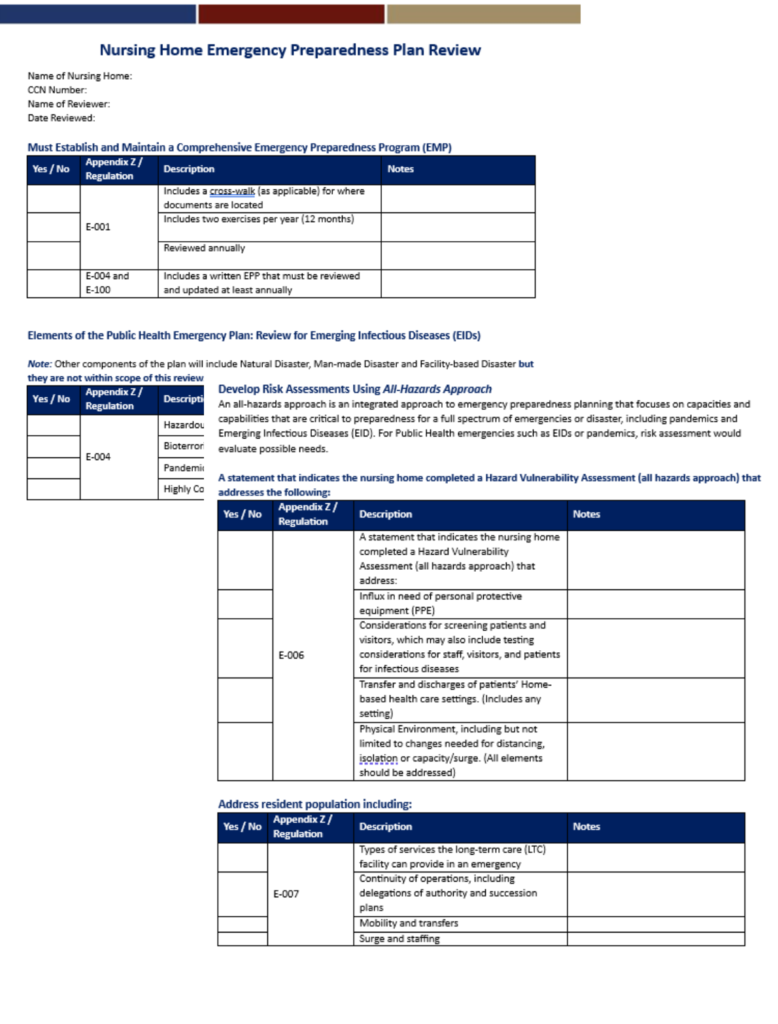
In November 2016, CMS issued an Emergency Preparedness Rule for all Medicare and Medicaid participating providers and suppliers. The purpose of this rule was to ensure providers and suppliers had the planning, the resources, and the community backing they needed to take care of both natural and man-made disasters. By November 2017, all providers and suppliers needed to be compliant with the regulations. 
Although most nursing homes met the federal regulation for emergency preparedness requirements, 77 percent reported challenges during an actual emergency. The two most cited concerns include appropriate staffing during and emergency and also evacuations of the facility which need transportation.
Since patient safety is a number one concern of CMS, it is almost guaranteed there will be focus on the facilities emergency preparedness plan during federal surveys.
One of the elements is the emergency preparedness plan needs to be reviewed on an annual basis. Great Plains QIN has developed the Long-Term Care (LTC) Emergency Preparedness Plan (EPP) Resource Document, which includes a comprehensive list of resources to utilize while updating your Emergency Preparedness plan. The Great Plains QIN team has also created a Nursing Home Emergency Preparedness Plan Review, which outlines each of the Appendix Z regulations to help ensure an Emergency Preparedness plan is up-to-date and has the foundation to be effective in the case of an emergency.
The four core elements to an emergency preparedness include:
1. Risk Assessment and Emergency Planning
- Hazards likely in geographic area
- Care-related emergencies
- Equipment and power failures
- Interruption in communications, including cyber attacks
- Loss of all/portion of facility and supplies
- Plan is to be reviewed and updated at least annually
2. Policies and Procedures
- Complies with federal and state laws
3. Communication plan
- Complies with federal and state laws
- System to contact staff, including patients’ physicians, other necessary persons
- Well-coordinated within the facility, across health care providers, and with state and local public health departments and emergency management agencies.
4. Training and testing
- Complies with federal and state laws
- Maintain and at a minimum update annually
 “We focus on nursing home quality and safety. Our team develops tools and resources for nursing home staff to utilize while reviewing or updating your emergency preparedness plan. We encourage nursing home team members to review and utilize the tools and resources to enhance quality of care so our loved ones receive the first-class care they deserve. If we can assist in any way, please connect with us; we would love to help,” shared Stephanie Meduna, RN, BSN; Quality Improvement Advisor.
“We focus on nursing home quality and safety. Our team develops tools and resources for nursing home staff to utilize while reviewing or updating your emergency preparedness plan. We encourage nursing home team members to review and utilize the tools and resources to enhance quality of care so our loved ones receive the first-class care they deserve. If we can assist in any way, please connect with us; we would love to help,” shared Stephanie Meduna, RN, BSN; Quality Improvement Advisor.
For more information, visit the GPQIN Nursing Home Quality Webpage.
